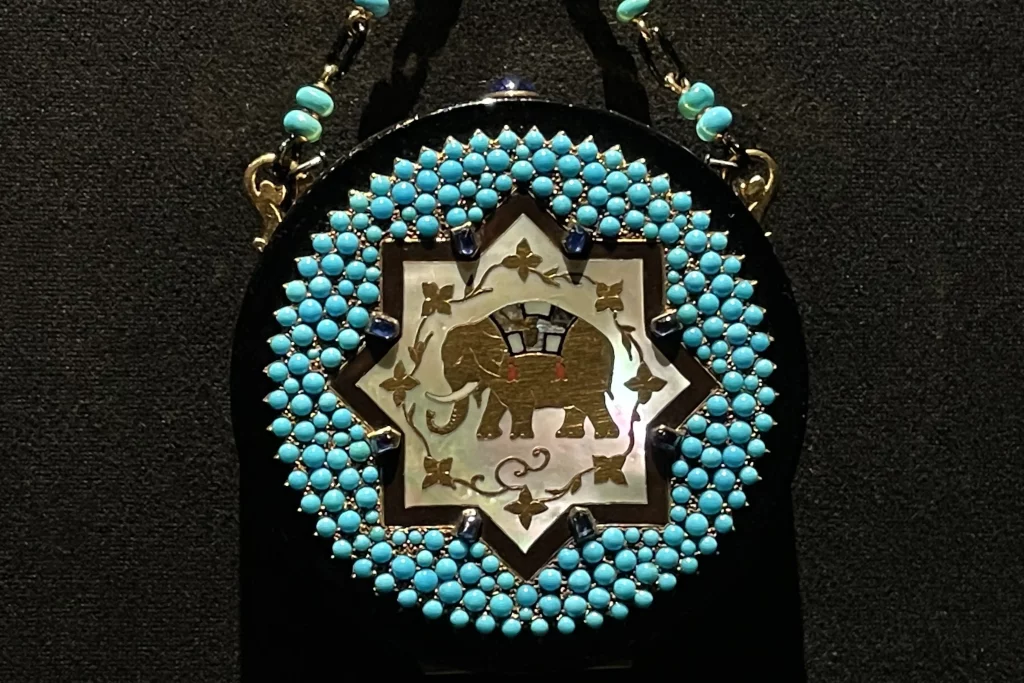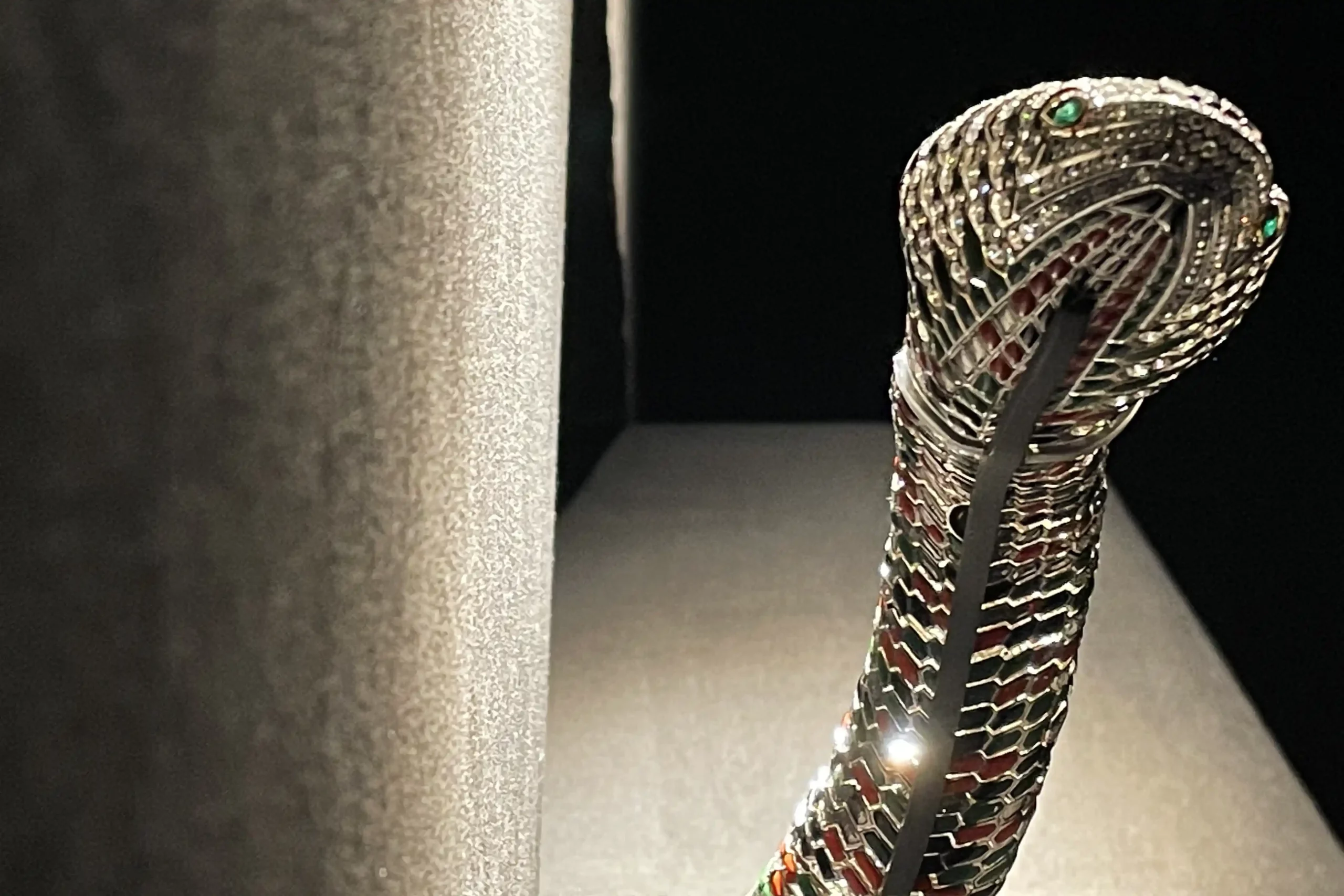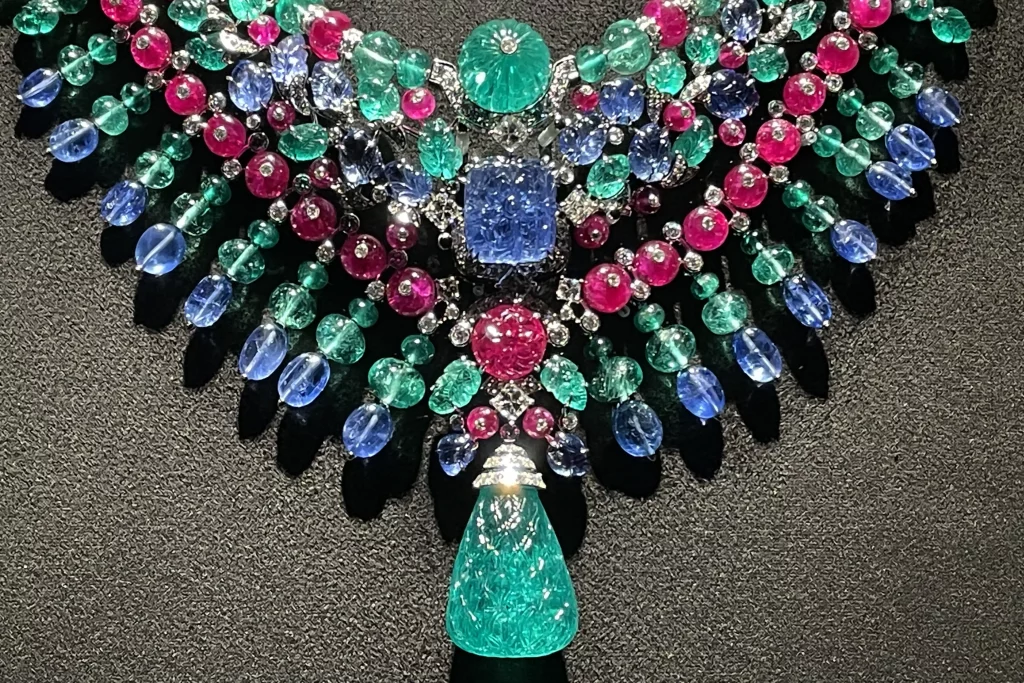The complexity of a narration between Paris and Mexico, reviewing the twentieth century: notes on aesthetics during a visit to the Cartier exhibition in Mexico City
Maria Felix, La Dona, the actress – she dressed in Balenciaga and bought Cartier’s jewels
A lock of gray hair remains hidden in videos and photos – but not in the movie Dona Barbara: for her role in this film, Maria Felix is known as La Dona. She managed to mix pop and snob in Mexico as well as a diva like Mina in Italy could have, but did not.
Her father descended from the Indios, Diego Rivera went crazy for her and divorced Frida Khalo. Maria Felix acted for Luis Bunuel, recited Jean Cocteau’s texts – she did not act for Visconti in Senso because Italian law prohibited foreign actresses from working on more than one film a year. She dressed Dior and Balenciaga, and bought Cartier jewelry.
Maria Felix and the Cartier panthers designed by Jeanne Toussaint, on display at Museo Jumex
Maria Felix was a wealthy woman, because of her career and her marriages, the last of which was to French banker Alex Berger. Maria Felix traveled between Mexico and France – in Paris, at Cartier, she bought jewelry designed by Jeanne Toussaint. She would buy panthers, the ones she liked in the boutique on rue de la Paix and the ones she commissioned as special orders. She wanted panthers in different poses, either tired and docile or aggressive. After her husband’s death in 1974, Felix felt the need to express her Mexican sensibility, to tell the story of Mexico that she carried in her blood: she asked Cartier to make two crocodiles, in gold, platinum and stones. She wanted them to be objects that could be worn, but also to be decorative elements for the table at a dinner party.
Maria Feliz, the crocodiles and snakes: Cartier Design. A Living Legacy
Cartier made a belt composed of gold coins, Mexican pesos for Maria Felix. Earrings like snakes are held up by going into the pavilion as two earpods are today. The snake necklace is about 50 centimeters long: it has a head that lifts up – Maria Felix wanted the snake to be there to attack you. It happened that she saw this snake necklace exposed resting on a pillow: she complained about it to Pierre Rainero, she was a bit offended: the snake was supposed to attack you, not stay comfortable, she said. There is a video where Maria Felix picks up this snake necklace and, holding it by the tail, spins it over her head: it is evidence of how the goldsmith’s craftsmanship was able to produce an artifact so flexible that it was adept at violent rotation. The back of the snake is covered with diamond scales, while on the belly, where the coils are thinner and smoother on the ground, the snake’s skin is a composition of enamel fragments, red, green and black.
Maria Felix managed to evolve her personal taste to an expression of a Central American cultural custom: she found the manners of Mexico and met Cartier’s attitude in jewelry. In those years, Cartier’s attitude was that of the director of the creative studio: Jeanne Toussaint. The entire exhibition at the Muso Jumex in Mexico City appears as a dialogue between these two women.
Cartier, Maria Felix and Jeanne Toussaint
The first panther was a gift given to her by Louis Cartier: a panther was worked, engraved and composed in diamonds on a cigarette case of black lacquer. Louis Cartier was in love with Jeanne Toussaint, but he did not marry her. Jeanne Toussaint took over the creative studio in 1933. She revived the use of yellow gold after platinum; movement was the focus of her craftsmanship, a stimulus to seek new solutions that she explained to the artisans by moving her arms to give pragmatic examples of the effect she wanted to achieve. She used jade, turquoise, amethyst, and topaz marking the era of high jewelry with semi-precious stones – as well as signing the pieces that are the story of Cartier today.
On display in Mexico City are the rubies owned by Lydia Deterding, wife of Henry Deterding who was president of Royal Oil (it would become Shell): they called him the Napoleon of Oil. Another frame is devoted to two brooches: in the first brooch, the bird is inside the cage; in the second brooch, the bird is outside the cage. Jeanne Toussaint was arrested by the Gestapo: this brooch became a symbol of French resistance against Nazi oppression.
Cartier and Mexico: the exhibit set designed by Frida Escobedo
The first jewel to appear in the exhibition is a brooch mimicking the steps of the Pyramid of the Sun, a diamond and black enamel (1915). The installation designed by Escobedo studio echoes the walls of the Mexican pyramids, studying Josef Albers’ reportage photographs in Tenayuca in 1937.
The exhibition is a shadowy path, where beams of light collide on horizontal grooves that echo the steps of the temples. Like mirrors, frames open up, focusing the light on the jewelry. Frida Escobedo is a Mexican architect, and as such she presents herself: she adds reference to the plateau on which the city stands whose cathedral floats on a lake, the mountains, the canyons, the stratigraphy of the soil. A brutalist result, Escobedo defines.
Cartier’s legacy, the exhibition in Mexico City: Cartier Design. A Living Legacy at the Museo Jumex
The core of the Cartier Heritage collection was defined in 1993. It appeared as the result of the work of an archival department that, along with the pieces of the goldsmith’s manufacture, had gathered historical and social information. The idea of a permanent Cartier Museum, to be opened to the public, was outlined.
Since 1993, the collection has been exhibited 38 times around the world: each time, it has been presented according to an independent curatorship that could find its own narrative slant. For Cartier Design. A Living Legacy at the Jumex Museum, curator Ana Elena Mallet captured the link between Maria Felix and Jeanne Toussaint, creating a conversation about the question that still persists: how can a selection of jewelry manage to tell the story of the production of more than a century?
Cartier’s style: from the Garland style to Art Deco: the first rooms of the exhibition in Mexico City
The garlands are a throwback to the Louis XVI era. We are in the early twentieth century, but innovations in style have not yet been chosen. Louis Cartier presents jewelry that are still decorative elements: they command respect and privilege.
A necklace reaches the thickness proper to a sash of rank at Versailles. A hair clip attaches above the neck to lock in the work of hairstyling – it is the artifact that marks the transition from garlands to the first echoes of Art Deco, when geometry begins to meet organic forms. The object is an ornament for the chignon and shows the disconnect between what was a decorative jewel and a research jewel. Louis Cartier composed a library available to the creative people of the time, where focus was given to architecture and not much to jewelry.
Cartier, Pierre Rainero – the private visit to the Jumex Museum for Cartier Design. A Living Legacy
In the 1920s we referred to style moderne in French – it was not until the 1950s that the term Deco came into use. «Because of World War I, international exhibitions were interrupted – as trade and travel resumed, different styles were encountered for which we use the term Art Deco today», explains Pierre Rainero, director of Heritage, Image and Style at Cartier, who opens the doors to the first private tour of the exhibition at the Jumex Museum, «All the innovations in manufacture and technology that had been conducted during the war years were presented after they had been broken in, so that the 1920s appeared in a variety unprecedented for tradition. It cannot be called an Art Deco style, but an Art Deco period, Art Deco being composed of many different styles».
The Art Deco period and the 1920s cusp – Cartier, an amethyst necklace and the juxtaposition of green and blue
In the Art Deco period, steel-based tiaras can be found, worked in platinum, diamonds and black enamel, such as the 1914 one for Lady Avery. Only a few years later, some customers returned to have emeralds added and color jewelry chosen. In 1926, women abandoned the corset: the body shape lengthened and necklaces descended along the profile and into the valley of the breasts. An amethyst sautoir belonged to Gladys Deacon, the Duchess of Marlborough who succeeded Consuelo Vanderbilt.
The first wristwatch for a woman was created. Geometry and volumetry became the codes for Cartier: when you are transforming something, you are – by logic – identifying its primary form. Louis Cartier mixed blue and green, which for Western taste in those years was almost taboo, while it appeared as a customary juxtaposition in Islamic culture. The blue and green were emeralds and sapphires – but also jade and turquoise in a pendant from 1913: «A year to keep in mind», Pierre Rainero pauses in front of the brooch – «because of the synchronicity with the evolution of the artist periods in Picasso’s art». A table clock – the Mystery Clock – marks time for Finance Minister José Yvoes Limantour in 1921.
Carlo Mazzoni


























